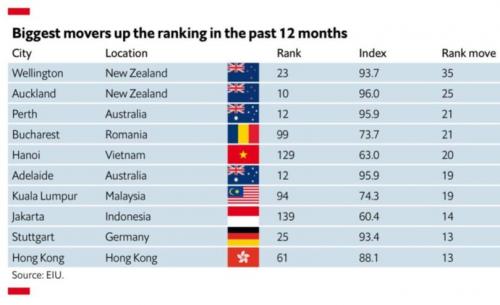
2023’s Global Liveability Index: The top 10
https://www.eiu.com/n/campaigns/global-liveability-index-2023/
1. Vienna, Austria
2. Copenhagen, Denmark
3. Melbourne, Australia
4. Sydney, Australia
5. Vancouver, Canada
6. Zurich, Switzerland
7. Calgary, Canada
7. Geneva, Switzerland
9. Toronto, Canada
10. Osaka, Japan
EIU’s Liveability Index has risen significantly in the 2023 survey, reaching a 15-year high as the world moves on from the covid-19 pandemic and healthcare and education scores improve in many cities in Asia and the Middle East and Africa. However, scores for stability have slipped backwards since last year, amid several instances of civil unrest around the world.
• Vienna (Austria) tops the rankings for 2023, owing to its winning combination of stability, good culture and entertainment, reliable infrastructure, and exemplary education and health services. It has occupied this position regularly over the past several years, with only the covid-19 pandemic causing the city to vacate its place at the top spot. • Copenhagen (Denmark) takes second place, while a shift towards normality after the pandemic has helped the Australian cities of Melbourne and Sydney to bounce back up the rankings to third and fourth place, following a sharp tumble in 2022.
Three cities in Canada, two in Switzerland, and two in Asia (a New Zealand and a Japanese city are joint tenth) make up the rest of the top ten positions. • Asia-Pacific cities have made some of the biggest gains, accounting for eight of top ten movers up the rankings as economies recover from the pandemic. Wellington (New Zealand) has soared by 35 places to 23rd place, Auckland (New Zealand) by 25, while Hanoi (Vietnam) has moved up 20 spots, as their covid restrictions were lifted.
• Western European cities have slipped down the rankings in the 2023 survey. Increased instances of workers’ strikes and civil unrest have hurt their stability ratings and they have failed to match gains made by cities in Asia and the Middle East.
• Kyiv is back in our survey, having been forced out by Russia’s invasion of Ukraine in February 2022. However, the city ranks a lowly 165th out of the 173 cities in our survey, with its stability and infrastructure damaged by the war. Moscow (Russia), which fell to 96th place in 2022, has remained stable this year.
• Damascus (Syria) and Tripoli (Libya) are still at the bottom of the list, held back by social unrest, terrorism and conflict. However, while Damascus has seen no improvement since last year, scores for Tripoli and other cities in the bottom ten have improved as the pandemic has receded.
Big comebacks
While Australia’s Melbourne and Sydney had dropped down the list in recent years, with Sydney dropping out of the top 10 recently and Melbourne tying for 10th place with Japan’s Osaka in 2022, both have shot back up, taking third and fourth place respectively.
Canada was well represented this year, with three of its cities – Calgary, Vancouver and Toronto — landing a spot in the top 10.
Meanwhile, Switzerland received two top 10 entries, with Zurich taking sixth place and Geneva tying for seventh place with Calgary.
Osaka, which saw a small boost in its culture and environment ratings due to the withdrawal of Covid-related restrictions, rounds out the top 10.
“The removal of covid-related restrictions has overall boded well for global liveability in 2023,” Upasana Dutt, Head of Liveability Index at EIU, said in a statement.
“Education has emerged stronger with children returning to schools alongside a significantly reduced burden on hospitals and healthcare systems, with some notable improvements in cities across developing economies of Asia and the Middle East.
“As the world’s political and economic axis continues to shift eastwards, we expect the cities in these regions to move slowly up our liveability rankings.”
About EIU
The world leader in global business intelligence EIU offers deep insight and analysis of the economic and political developments in the increasingly complex global environment; identifying opportunities, trends, and risks on a global and national scale. Formed in 1946, with more than 70 years of experience, it is ideally positioned to be a commentator, interpreter and forecaster on the phenomenon of globalisation as it gathers pace, enabling businesses, financial firms, educational institutions and governments to plan effectively for uncertain futures.










Add new comment